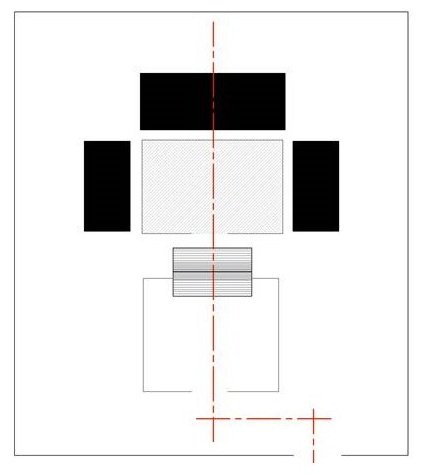
The Axis is the most common organising principle among all architecture principles. It is an imaginary line that is used to arrange a group of elements in the design. It is usually represented by a dashed line in drawings & diagrams.
The architect initially thinks about their designs in terms of the architecture principles, but they are primarily used as a tool to understand what the design achieves. The easiest way to find the architecture principles is to look at a building, floor plan, or a map & see what catches your eye; then ask yourself, What part of the building is most noticeable? What did the architect had done to make it stand out?

Axis (important among architecture principles) is defined as “A line established by two points in space, about which forms and spaces can be arranged in a symmetrical or balanced manner.”
The axis is a central line that initially helps to organise a design. Often the axis is at the centre of a building or over an entrance doorway.
The Axis – one of most common architecture principles, gives the length, direction, induces movement and also promotes views along its path and it must be terminated at both ends by a significant form and space.
When the architect use axis or focal point in their design it acts like a straight arrow on a sign, pointing you in the right direction. As for example, Taj Mahal at Agra is planned by following the axis as a focal point to an entrance doorway so that the building is focused on the central tomb chamber.

Here is the example of Courtyard house in China with a schematic sketch on the right side showing the how spaces are arranged and planned through the axis.

Another example is a Hotel in Paris which shows how axis is followed in planning different spaces as shown in the figure.
We Can Show Following Characters by Using Axis in Design:
01. Alignment
02. Reinforcement
03. Movement
04. Continuous
01. Alignment:
Axis is used to align elements in the design. When it is arranged by axis, the design is that in order. We enjoy things that are in order because those things look more stable, comfortable and approachable.
02. Reinforcement:
We can make axis more apparent if the edge of surrounding elements is well defined. The best example of this concept in architecture is a street of the city. The streets of the city are an axis that is reinforced by the buildings on both sides. If a portion of the street is missing somewhere in one or both sides, the axis in street would not feel strong.

03. Movement:
When we see something linear, we naturally follow the line in a direction of axis. If we arrive on road and came in contact with pathway beside the road, the pathway will give the movement for walking. The direction of the movement depends on the end point. A well-defined end point signals a place for a stop or new start.

04. Continuous:
If an end point is undefined, the person will follow the axis until he reaches the destination. The concept of an undefined end point in architecture is uncommon because it is difficult for something in architectural design to go on forever. It’s becoming more popular in product design.
Architectural Elements Which Follow the Axis Principle:
The terminating architectural elements of an axis serve to both send and receive its visual thrust. These culminating elements can be any of the following:
01. Points in space established by vertical, linear elements or centralised building forms.

02. Vertical planes, such as symmetrical building facades or fronts, preceded by a forecourt or similar open space.

03. Well-defined spaces, generally centralised or regular in form.

04. Gateways that open outward a view or vista beyond.

These are the important points of the axis the architect or designer should initially think while planning the shapes and forms of any structure or a building.
































